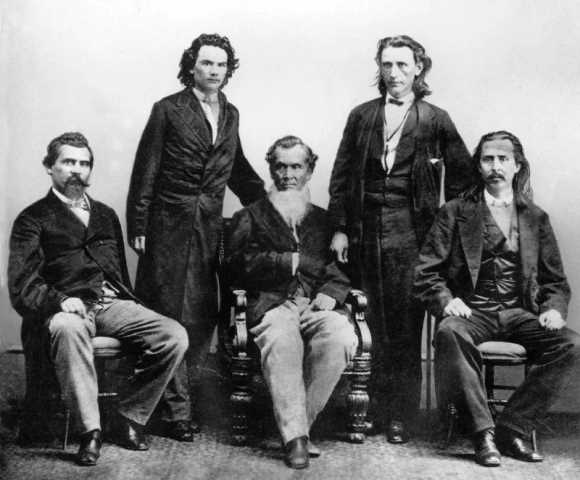Introduction to the Trail of Tears
Many people think of the Cherokee of the mid 1800’s as a half clothed man in war paint carrying a bow and arrow and a mother and children standing outside a teepee.
This view is utterly wrong.
Most of the Cherokee of this time would be classified as middle class and some were quite wealthy. Some homes survive, most notably the two Ridge homes in Rome, the Ross home east of Dalton and the Adair home in Ranger.
Most of the Cherokee leadership had educated their children at some of the most prestigious schools in New England, and even the lesser families could read and write. There was a newspaper being published in Cherokee at New Echota and by-and-large the Cherokee had adopted Christianity and "white American lifestyle"due to the work of the Moravian, Methodist, and Presbyterian missionaries.

Pictured: Cherokee leaders in Washington, DC in 1866.
In early 1838, the U.S. government built 14 stockades designed to hold 8,.000 people. None were here in Bartow (then Cass) county, but there was one at Cedartown, Ft Means on the Floyd county line and Camp Malone in Rome. By the first of the summer, 15,000 people had been crammed into these stockades awaiting removal to Oklahoma. All told, it took just 20 days to round up the Cherokee people and march them to the various stockades where they slept on bare ground – conditions most of these people, and especially the children had never experienced, but was a harbinger of the holocaust to come.
Rev. Daniel S. Butrick ran a mission near Rome, GA and was an eyewitness to the events:
“Thus in two or three days about 8,000 people, many of whom were in good circumstances, and some rich, were rendered homeless, houseless, and penniless, and exposed to all the ills of captivity. In driving them, a platoon of soldiers walked before and behind, and a file of soldiers on each side, armed with all the common appalling instruments of death; while the soldiers it is said would often use the same language as if driving hogs, and goad them forward with their bayonets.
One man, on being pricked thus, and seeing his children thus goaded on, picked up a stone and struck a soldier; but for this he was handcuffed, and on arriving at the fort, was punished and on starting again was whipped a hundred lashes.”
Sources:
Futrick, Daniel. The Journal of Daniel Butrick.